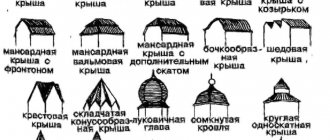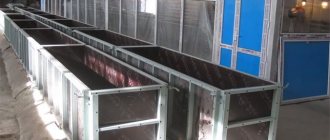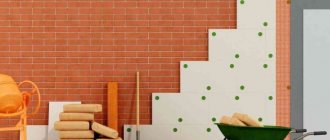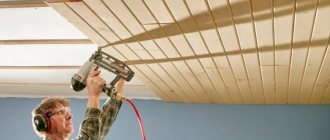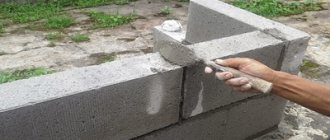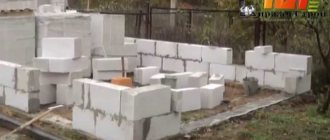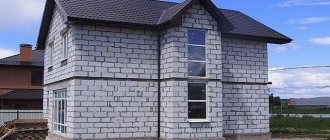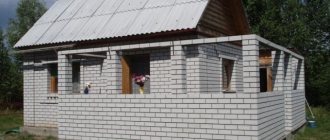Today we will try to answer the question of how to decorate the facade. Or more precisely, what finishing options for foam blocks exist. First, I would like to clarify why external wall decoration made of foam blocks is needed. After all, if the masonry is done smoothly and the seams are treated, then the house can be left without finishing at all. This also has its own truth! However, unprotected foam blocks can be damaged as a result of any mechanical impact - chips and cracks appear. Dust and dirt will accumulate in the pores of the foam blocks, and the walls will become wet from exposure to rainwater. The mixture of dirt and water can form an acidic reaction, causing the walls to darken unevenly in patches. The house will have an unsightly aesthetic appearance. But most importantly, the “no finishing” option significantly reduces the period of use of the walls, and this is a more serious problem than the appearance of the house.
Requirements for finishing material
Foam block belongs to the category of porous building materials. In its production, a gas-forming substance is used, due to which more bubbles appear inside the solidifying mixture.
Thanks to this, the walls have a high degree of vapor permeability. Natural air infiltration passing through the enclosing structures helps to establish a microclimate comfortable for living inside the home. The material “breathes”. That is, our main condition when choosing the finishing of a building should be the absence of obstacles to the escape of water vapor from the interior. In other words, the instructions tell us that if the finishing is improper, we retain water vapor, which begins to accumulate in the foam concrete material. As a result, we get the accumulation of moisture in the body of the block and its destruction.
Foam blocks themselves do not have high mechanical strength and can be damaged as a result of mechanical stress. In addition, they will absorb water, which will freeze at subzero temperatures and destroy the blocks.
Therefore, you need to choose finishing options for foam blocks taking into account the characteristics given in the table.
Let us indicate which finishing options for foam blocks are definitely not suitable :
- Ceramic tile;
- Concrete tiles;
- Plates made of foamed polymer;
- Conventional plaster with a mortar based on sand and cement;
- Paints that will form a film on the surface of the walls.
Features of foam concrete blocks
First, you need to familiarize yourself with the main technological characteristics, as well as the structural features of foam concrete blocks, in order to understand why finishing walls from such a building material requires a special approach.
First of all, you need to pay attention to its porous structure:
- The porous structure allows it to have low weight and good thermal insulation characteristics, but at the same time it has poor resistance to moisture and poor resistance to mechanical stress with an unattractive appearance.
- If the blocks are not protected, they can gain moisture and freeze in the winter. After each freeze-thaw cycle, it loses its strength. Standard blocks are designed for 25 such cycles. But there are winters when temperature fluctuations are significant and there can be several such cycles in one winter. In a couple of years, the defenseless foam block structure will begin to collapse before our eyes.
When designing foam block structures, the following should be provided:
- Availability of drainage.
- Availability of visors.
- Presence of window sills.
- Possibility of protecting the basement of the building from moisture.
- Installation of a roof made according to technology.
Attention: The design of the walls, together with the cladding, must facilitate the removal of vapors from the wall structure, otherwise the walls will absorb moisture and remain damp throughout the entire heating period.
External cladding materials
Frequently used and popular finishing options for foam blocks are surface cladding with ceramic (clinker) bricks, natural stone or facade tiles.
Brick
One of the most common materials. The brick is laid at a distance of 5 cm from the main foam concrete wall to create a ventilation gap. In order for the decorative masonry to be even, experts advise using a technological sheet, which at the same time prevents the installation mortar from getting into the gap between the main and decorative walls. As it moves up, the sheet rises along the masonry.
Facing foam blocks with bricks
Ventilation holes must be left under the eaves in the brickwork rows. Their total area should be approximately 2% of the wall area. If the house is not intended to be used during the cold season, ventilation may not be necessary. But be prepared for increased humidity levels inside living rooms.
Pros:
- Facing brick reliably protects foam block walls from precipitation;
- External finishing gives additional strength and stability to the constructed building;
- The material significantly increases the service life of the building’s load-bearing walls;
- Clinker brick finishing can be used under strong temperature fluctuations. At the same time, it does not lose its original appearance and strength;
- During operation, the described finish does not require additional maintenance, constant touch-up or plastering.
Minuses:
- In some cases, whitish spots (efflorescence) may appear on the finish, which worsen the appearance of the building;
- Brick finishing is quite expensive. You can choose and use budget options.
A natural stone
The weight of the finish will be very large, so to install it you need to have a very reliable and fairly wide foundation. It is necessary to take care of its design even before the construction of the house begins.
Options for finishing foam blocks with natural stone
Pros:
- Attractive appearance. There are a huge number of finishes on the market - from wild stone to polished tiles made from it. Options for finishing foam blocks with natural stone are limited only by your imagination;
- Practicality. The stone reliably resists destructive external influences: water, sun, frost, etc. This type of finishing of a foam block house will last as long as possible.
Minuses:
- Partial destruction of the facade. Due to poor-quality installation, natural stone may peel off from the foam concrete. However, there is nothing to worry about, since spot repairs are not difficult even for a non-professional;
- Possible radioactivity. Some types of minerals emit radiation, but the dose of radiation received is very small and is completely within established limits.
Tile
Options for finishing foam blocks with tiles
Finishing a house from foam blocks from the outside does not require a protruding foundation, since the cladding is glued to the walls and does not rest on the base. At the same time, it reliably protects the porous material from external influences, and its appearance can imitate many materials, including natural stone or ceramic brick.
The following types of tiles can be used for exterior finishing of foam block facades:
- Facade ceramic. For external work it is necessary to use frost-resistant tiles;
- Porcelain tiles;
- Clinker tiles.
Pros:
- The tiles do not allow moisture to pass through to the foam blocks. There are no microcracks in it, which are inherent, for example, in natural stone;
- The tiles withstand external mechanical stress well;
- The facing tiles retain their technical characteristics regardless of the ambient temperature. It tolerates high temperatures in summer and low temperatures in winter;
- Using different colors and textures, it is very easy to give a boring foam block structure a new look.
Minuses:
- The main disadvantage of the tile is its low vapor permeability. The finishing almost completely stops air infiltration;
- The cost of the finishing described cannot be considered budget, but it is not the most expensive either. However, here you also need to take into account the costs of preparing the surface, purchasing glue and other nuances.
- The total weight of the tiles can be quite large, which must be taken into account when calculating the strength characteristics of the foundation of the house.
Technology of facing the facade of a house made of gas-foam blocks with stone
By choosing stone for home decoration, in addition to beauty and elegance, you get significant savings on heating (10-15%).
The cladding process is not that complicated. The surface of walls made of aerated blocks (if they are of high quality, they have been “dried”) does not need to be plastered, limiting itself to the installation of a facing mesh. The mesh is reinforced with dowel nails, thereby ensuring better adhesion of the tiles.
The main point is the selection of glue that matches the vapor permeability properties of aerated concrete. We recommend using adhesive for aerated concrete and stone cladding. Its adhesion rate is higher than that of tile adhesive.
The wall cladding itself is made from foam blocks using the methods of pouring or laying stone tiles on a mortar. Filling - when a row of stone tiles is laid out, and the space between the wall and the tile is filled with a liquid adhesive solution. This method is not always suitable, since the thickness of the tiles can be 15-20mm.
An important point is strengthening the row of tiles. Strengthening is often done by installing dowel nails directly onto the tiles.
That is, a hole is drilled in the tile wall of a house made of aerated concrete, where a dowel nail is installed. The length of the nail depends on the thickness of the adhesive mixture and the tile and should not exceed 75mm. Above this size, a thermal bridge is formed.
The construction of houses and cottages is the main activity of the construction industry. For 20 years now, we have been constantly improving construction methods, trying new technologies and materials, which ultimately allowed us to determine for ourselves the most promising scenarios for the construction of modern houses in the Moscow and Tula regions.
First, let’s clarify: the word “cottage” does not necessarily mean a luxurious mansion with major renovations and elite landscaping (although we carry out such projects at the highest professional level). This may well be a small cozy house with an area of 70 m2, affordable for a family with ordinary income.
Plaster
For cellular material, it is necessary to use plaster, which prevents atmospheric moisture from being absorbed into the enclosing structures. The top should be painted with vapor-permeable facade paint or covered with decorative facade plaster (for example, “bark beetle” or the like).
This option should be recognized as one of the inexpensive and easy to implement, but not very durable. In addition, you still need to have some skills in leveling surfaces using plaster mortar. The surface must be properly prepared before plastering. Typically, foam blocks are cleaned of dirt, dust-free, and primed. Only after this are two layers of plaster applied - starting and finishing. Naturally, compositions that form a vapor-permeable layer should be used.
Plaster can be ordinary or colored, with the addition of stone chips or terrazite - designed to create relief surfaces. Where there is a special load on the walls (corners, places above window and door openings), it is better to use reinforcing mesh under the plaster. Plaster is an economical type of exterior finishing; it is easy to apply, dries quickly, looks great, and can be combined with other types of cladding - for example, artificial stone. If you follow the technology for applying plaster, it will not crack for a long time and will not fade in the sun.
Fiberglass mesh is used to strengthen the plaster. It reinforces the solution, preventing it from crumbling and collapsing during operation.
Resort to plastering in cases where you are going to simultaneously insulate the house using foam plastic or mineral mats. Then the plaster simultaneously serves as a protective layer and decorative finish for the insulation.
Pros:
- The finish has hydrophobic properties. This allows foam concrete blocks to maintain their integrity for a long time;
- Hardened plaster has good strength and protects blocks from damage as a result of external mechanical influence;
- The material does not prevent air diffusion through foam blocks. The water vapor accumulated inside is released outside;
- With the help of decorative plaster, you can effectively decorate the facade of a building using materials of different colors and textures. The possibility of tinting the composition or painting it with paint further diversifies the exterior;
- The cost of material and application of plaster is quite affordable for all our compatriots.
Minuses:
- To apply plaster on walls you need to have certain skills and have the appropriate tools;
- The service life of plaster until the next repair or restoration does not exceed 10 years;
- The material is sensitive to vibration and can crumble when the base vibrates;
- Preparation of the composition and its application requires strict adherence to the proposed technology.
Subtleties when building a house made of bricks and foam blocks
Making foam block masonry is easier and faster than building a brick wall - the blocks are lighter in weight and larger in size, they are easy to saw and change shape. But there is one specific feature of block construction that is worth remembering - the need to waterproof the bases of walls from roofing material or waterproofing.
Professional builders have their own subtleties. For example, they often refuse to lay blocks on cement mortar, but fasten them together with special glue. The adhesive fastening technology makes it possible to achieve a minimum thickness of seams, which creates additional moisture protection for the structure.
If laying foam blocks is not particularly difficult, brick cladding of facades requires a professional approach. It is better to invite a specialist for this work who will carry out the finishing in compliance with modern construction standards and the aesthetic qualities of the material.
Compliance with the subtleties and technologies of constructing residential buildings from foam blocks lined with brick ensures that your home will be beautiful, warm, reliable, inexpensive and will last for many years, delighting all members of your family.
Foam blocks are a relatively recent invention. Relatively, when compared with traditional building materials, for example, the same brick. If you read the Internet, the information is, frankly speaking, ambiguous.
As a rule, only manufacturers praise, and theorists who have not held a foam block in their hands try to find shortcomings. Those who want to build a house from foam blocks cannot decide. That’s how, in fact, this article was born: we decided to collect feedback from owners from their former customers and not only in order to be curious ourselves and at the same time share their impressions with you. Below we will present reviews from real owners of foam block houses.
We think that this approach will be fair, because these will be real comments, and not an attempt to once again praise or humiliate foam block manufacturers. In order to be as objective as possible, we decided to maintain the style of presenting thoughts, removing only in some cases obscene expressions. So, here we go:
“The most difficult thing for me was deciding on the thickness of the walls. Everyone around was already squealing that it could be done more subtly, but it was somehow scary. He spat on everyone and everything and did it according to the dictates of his soul - the walls turned out to be 50 centimeters.
No cladding, no insulation. Only façade putty on the outside and putty on the inside. The result so far (the house is 2 years old - approx.
author) that he is satisfied. It's warm in winter, not hot in summer. Not cool as we would like, but not hot.”
“What can I say, a house is like a house. We need to survive one winter and live through a hot summer, then I’ll tell you.
For now I can only talk about convenience. It was a pleasure to dabble, cut and putty. This is not a brick with its dust after an angle grinder.”
“The wall is cracked - that’s my impression! Moreover, I can’t understand where my fault is: the foundation is excellent - I didn’t skimp on it, the masonry is high-quality - it seems like I’ve been building it for several years. And it cracked, it was an infection. I’m only sinning on the floor slabs, maybe there’s an uneven load.”
“It was all this “the wall must breathe” that influenced my choice.
God knows how she should breathe, but there seems to be no condensation, mold or other nonsense. However, there is no ventilation. I opened the door and windows - that’s all the ventilation for you.”
“On a pleasant note: I liked working with blocks. Lightweight, easy to cut, construction was quick.
I threw away the box myself during my vacation! From the negative side, I can say one thing: the foam block cost me a lot, but I haven’t noticed a payback yet. I pay the same money for heating as in the old house. Maybe a little cheaper, but not much."
“What can I say...
Everything seems to be fine, my wife is happy, and so am I. Unless you can really screw nothing into the wall. Well, you can add a picture there, and I was confused about hanging the cabinets in the kitchen.
The self-tapping screw won’t hold, no matter how hard you screw it, or even into a dowel! I screwed in 20 cm screws. It seems to be holding, but I warned my wife not to overload the cabinets. And with batteries it’s the same parsley – only long screws.”
“I did a very stupid thing - I decided to leave the façade unfinished until next season. The November rains have soaked the walls so much that I am afraid of frost.
I suppose that in the spring “joy” awaits me in the form of cracked walls. Well, it’s already January, and there haven’t been any significant frosts. Come in April and see for yourself.”
“I won’t lie - what I bought it for is what I sell it for: I was lucky, I bought a branded one. And on Vorontsovskaya (street - author's note) an eccentric built it from self-propelled guns.
I don’t know where he dug it, but the house is even ready for demolition - it’s all covered in cracks. I went to see it myself: the condition was terrible, the blocks were crumbling under any pressure. The guy himself is a builder, he did everything according to the rules, and he built it for himself after all.
And on you: the stick got caught. So it’s interesting: you can’t tell right away. And after a couple of months, the devil took over.”
“I had a choice: shell rock or foam block. I would have cladding the outside anyway, so the simplicity of the interior decoration became the determining factor. It takes a long time to tinker with shell rock, but the foam block is smooth.
What am I saying, you know it yourself. For the interior finishing I spent only on putty, but with shell rock I would have spent on both plaster and putty. And plus time, and you have to value it.”
“When I was looking closely at the choice of foam blocks, I decided for myself: cheap, fast, warm and durable.
Two things have definitely been accomplished now: they built it quickly and the house is warm. As for cheapness, this is a moot point. And I can’t say for sure about durability either, because only 4 years have passed.”
“You see, we don’t really know anything about construction.
There are so many nuances here that no one will really tell you anything - everyone will praise their own material. This is already my third home. The first one was made of adobe – still my father’s.
Cool house, I would love to go back there now. But.. The second one was made of silicate brick - bullshit, not a house.
For 15 years all I did was cover up the cracks and conduct experiments with heating - the whole family couldn’t get warm. And this one is normal. Compared to the previous ones, it’s worse than adobe, but much better than brick.”
“I decided to build, even though I had never practiced it. Experience only in the form of a dry theory from the Internet. What convinced me was that the house was small, only 6*6 meters.
I thought I could handle it and now, you see. I sent out the box myself, and it took 24 or 26 days. I put blocks on glue and read about cold bridges.
It was because of this that it took me a long time to tinker - well, I can’t work with a spatula and make such thin seams. But now he’s proud: he built it himself and is holding on. It cracked in one place, under the window, but God bless it, it stands and stands.”
“I decided to insulate it - I don’t trust these traders. On the outside, the mineral wool is 50 mm, and the walls themselves are 40 centimeters. It’s warm, but my heating is good: heated floors in every room and radiators on the walls.”
“I regret that I listened to my friends.
Yes, they built it for me quickly and seemed to be of high quality. But I threw in some money - don’t worry, mom. The foam block itself plus glue plus work plus insulation plus cladding plus finishing inside.
It would be better if I built it from a shell (shell rock – author’s note) and lined it with used bricks. I chased modern fucking methods.”
Instead of a conclusion
We think that enough conclusions can be drawn from these owner reviews. A house made of foam blocks has all sides - both positive and negative - and this is logical.
At least, we do not know of such a building material for the construction of walls that could be called ideal in all respects of the word. Some shortcomings will be present in any case. On our own behalf, we’ll also add that no one said anything about environmental friendliness and we think you noticed it too.
We believe that it is impossible to notice visible negative factors in terms of ecology, just as it is impossible to feel your own growth. There is nothing so terrible in the contents of the foam blocks. In any case, if we are talking about certified production.
- The content of the article
You can use different materials to build your own home, but aerated concrete is especially popular.
It has excellent thermal insulation properties and allows you to get a truly warm home; the main advantages are added: low cost, speed of installation, speed of construction and safety for others. There are few disadvantages, and one of them is the limitation in the choice of materials for finishing (for example, the usual use of cement plaster is not suitable, it cannot be coated with film-forming paints). How then to cover the outside of a house made of aerated concrete, and what materials are better to choose for it or alternatives from foam blocks or gas silicate?
Ventilated facade
If you built a house from foam blocks, then I advise you to use this particular finishing method. In this case, a ventilation gap remains between the decorative material and the main load-bearing wall, thanks to which the vapor permeability of the surfaces is not impaired, which has a positive effect on the life of the house and the microclimate in it. The following foam block finishing options can be used as a ventilated facade:
Facade cassettes
Wall cladding with a cassette aluminum curtain wall structure is most often used for decorating and insulating the facades of multi-storey buildings and industrial premises. The disadvantage of this material is its rather high price. Therefore, in private construction such cladding is extremely rare.
When purchasing a hanging cassette facade system, you will receive everything you need for its installation, and the installation process itself is described in detail in the instructions and usually does not cause difficulties.
Corrugated sheet
It is a metal sheet of a certain shape (with ridges and recesses), which is installed on a pre-designed sheathing.
Metal profiled sheets are protected from the destructive effects of the environment by an outer decorative layer, which usually comes in two types:
- zinc coating is a budget option for corrugated sheeting, which does not have outstanding decorative properties, but is able to reliably protect foam blocks from mechanical stress and moisture;
- polymer coating - is highly resistant to external influences and has an attractive appearance; it can have different colors and textures, which makes it possible to diversify the exterior of the building.
Polymer coating is much better than zinc.
Options for finishing foam blocks with corrugated sheets
Pros:
- Ease and simplicity of installation of the profile. To install the cladding, you need a simple frame that is attached to the foam block walls;
- Resistance to external weathering, corrosion and biocorrosion. The material does not require additional finishing (for example, painting or antiseptic treatment), which is usually used when facing a block house or clapboard;
- Durability and ease of maintenance of the façade finished with this material. The profiled sheet does not require any additional maintenance during its entire service life. If the protective and decorative layer is severely damaged, it is better to completely replace the part;
- Fire resistance. The material is not flammable and does not contribute to the spread of flame;
- Wide range of colors. The polymer coating of profiled sheets can have different colors;
- The corrugated sheet is completely sealed and does not allow moisture to penetrate to the load-bearing (enclosing) walls made of foam blocks.
Minuses:
- The high level of noise produced by the corrugated sheet during rain.
Vinyl siding
Another popular finishing option, which can easily be classified as quite budget-friendly. We are talking about panels made of plastic. Thanks to special additives, the polymer acquires various colors and shades, increased strength and excellent performance properties.
Pros:
- Vinyl siding does not absorb moisture during rain and melting snow;
- It is distinguished by a wide variety of colors that do not fade in direct sunlight throughout its entire service life;
- The material withstands impact well;
- Vinyl siding does not rust over time and is not subject to biocorrosion, regardless of operating conditions;
- You can install the finishing material yourself by securing the siding sheets to a pre-designed frame.
Minuses:
- Poor-quality finishing material can crack due to strong temperature changes;
- If the installation order is not followed, vinyl sheets may be destroyed by strong winds.
Please note: when installing PVC siding panels, keep in mind that vinyl has a significant coefficient of expansion or contraction with temperature changes, so do not nail or screw too hard to allow the panel to move freely.
Fiber cement boards
Fiber cement boards are a modern type of finishing that provides high-quality ventilation of walls and at the same time reliably protects the building from moisture and heat loss.
In addition, finishing the walls made of foam blocks on the outside with fiberboards allows you to decorate the facade in an original, stylish and modern way.
Before decorating the outside walls of foam blocks with fiber cement slabs, it is advisable to create a 3D project of the house. This will allow you to choose the most suitable texture and color of the material.
Options for finishing foam blocks with fiber cement boards
Block house
This type of facade will also allow air to pass through well. The block house consists of boards that look like timber or logs. They are mounted on the main slatted or profile base with a gap to remove water vapor.
Options for finishing foam blocks with block house panels
Materials for interior finishing
When choosing options for interior wall decoration, we focus on vapor permeability and moisture-repellent properties. From the premises, the foam block is also subject to negative influences. For internal cladding choose:
- Plaster - will help level the surface, release steam to the outside, and keep the foam block dry, even if the wall is watered with a hose. For strength, a reinforcing mesh is used. In the future, the plaster will be decorated with wallpaper or paint.
- Wooden lining. As you know, wood perfectly transmits steam and at the same time can protect the outer wall. The main disadvantage is the need to regularly renew the protective layer of varnish or paint. The lining is installed on the frame, which allows for an additional ventilated gap to remove vapors.
- Drywall is also a good option for leveling interior walls, especially if you plan to make complex structures. I install the material with adhesive or frame, depending on what scope of work is planned to be done next. After installation, the drywall is puttied and painted or decorated with wallpaper.
Foam block is an excellent material for the rapid construction of residential buildings, but at the same time it requires a protective coating. If this is not done, then in a decade the walls will begin to collapse, and strengthening them is much more difficult and expensive than taking care of high-quality cladding at the beginning.
Vapor permeable paint
Decorating a house using vapor-permeable paints is the simplest and most affordable option. The best option is paints containing silicone resins. They have good water-repellent properties, are resistant to precipitation and prevent the appearance of mold, mildew and microorganisms.
Compared to other products, they cope better with moisture, maintaining color saturation and structural integrity. In addition, before painting with such mixtures, walls do not need to be additionally impregnated with solutions with fungicidal additives.
Vapor-permeable silicone paints are most often available as an emulsion, completely suitable for consumption. To begin coloring, the mixture is pre-mixed; in some cases, 1%-2% pure water is added. Apply the mixture with a roller or brush in several layers with a break between them of 6-8 hours.
Finishing a foam concrete facade with paint from the outside is not only a simple, but also an economical way. Painting does not require any special skills; anyone can apply the mixture to the walls with their own hands.
Just as in the case of finishing with decorative plaster, the base will need to be prepared before painting - using glue and foam concrete chips. You also cannot do without priming - the solution is applied to the surface immediately before painting.
It is also important that such paint does not soften from heat, that is, dust and dirt do not stick to it in the summer.
Painting facade textured paint
Facade textured paints are also perfect for decorating the walls of a house made of foam blocks, aerated concrete and gas silicate; their advantage is a wide color palette. You can replace the paint with a thin layer of special vapor-proof putty (such as, for example, “Prospectors”), after the coating dries, the wall will acquire a neat appearance. At the same time, do not forget about pre-grouting the joints and eliminating surface unevenness.
Sources:
- al-kam.ru
- fortik.ru
- www.depstroi.ru
- paneligid.ru
There are no similar posts, but there are more interesting ones.


